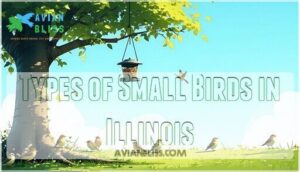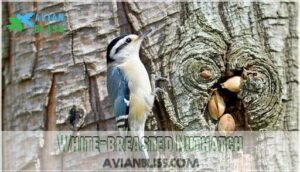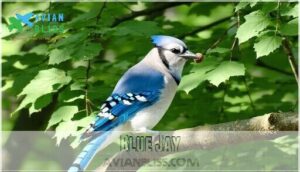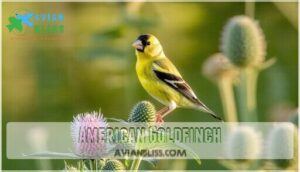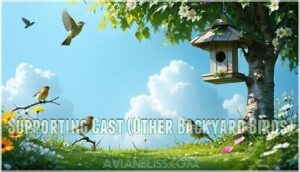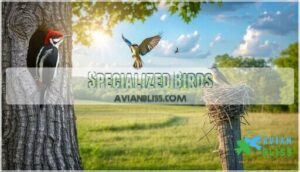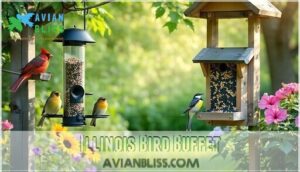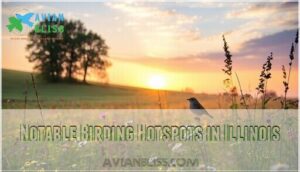This site is supported by our readers. We may earn a commission, at no cost to you, if you purchase through links.
 You’ll discover over 25 small birds in Illinois that’ll keep your backyard buzzing year-round.
You’ll discover over 25 small birds in Illinois that’ll keep your backyard buzzing year-round.
From the acrobatic White-breasted Nuthatch that walks headfirst down tree trunks to the vibrant American Goldfinch performing its trademark bouncing flight, these feathered residents and seasonal visitors offer endless entertainment.
Year-round species like Black-capped Chickadees and House Finches provide consistent activity, while migrants such as Ruby-throated Hummingbirds and Baltimore Orioles add seasonal excitement.
Each species brings distinct behaviors, calls, and field marks that make identification surprisingly straightforward once you know what to watch for.
Table Of Contents
- Key Takeaways
- Types of Small Birds in Illinois
- Common Year-round Resident Birds
- Birds of Spring, Summer, and Early Fall
- Fall and Winter Birds
- Supporting Cast (Other Backyard Birds)
- Notable Migrant Birds
- Specialized Birds
- Illinois Bird Buffet
- Notable Birding Hotspots in Illinois
- Frequently Asked Questions (FAQs)
- What is the smallest bird in Illinois?
- What are the small GREY and brown birds in Illinois?
- How do I identify a bird in my backyard?
- What are the tiny black and white birds in Illinois?
- What time of year do small birds migrate through Illinois?
- How can I identify small bird species by their songs?
- Which small birds are endangered or threatened in Illinois?
- How do I prevent small birds from hitting my windows?
- Conclusion
Key Takeaways
- You’ll enjoy year-round bird activity with permanent residents like Black-capped Chickadees, White-breasted Nuthatches, and Northern Cardinals providing consistent entertainment at feeders and in backyards throughout all seasons.
- Spring and summer bring exciting migrants including Ruby-throated Hummingbirds, Baltimore Orioles, and various warblers that arrive from Central America to breed, offering seasonal variety to your backyard birdwatching experience.
- You can easily identify most species by learning key field marks like the American Goldfinch’s bouncing flight pattern, the Blue Jay’s distinctive crest, and the House Finch’s red coloring on males.
- You’ll attract diverse species with proper feeding strategies using black oil sunflower seeds for cardinals and chickadees, nyjer thistle for goldfinches, and suet for woodpeckers and nuthatches at strategically positioned feeders.
Types of Small Birds in Illinois
You’ll spot dozens of small bird species throughout Illinois, from tiny chickadees to colorful finches.
These feathered residents transform ordinary backyards into wildlife sanctuaries through strategic bird feeding tips and habitat management.
Illinois bird species include year-round favorites like northern cardinals and seasonal visitors such as indigo buntings.
Small bird identification becomes easier when you understand their behaviors and preferred small bird habitats.
Urban birdwatching thrives in cities where house finches and sparrows adapt to concrete jungles, while backyard birds illinois offers glimpse into woodland species like nuthatches and wrens.
Illinois bird conservation efforts help protect these creatures facing habitat loss.
You’ll discover that backyard birding supports local ecosystems while providing endless entertainment.
Whether you’re watching goldfinches at feeders or spotting warblers during migration, small birds create daily opportunities for connection with nature right outside your window.
Common Year-round Resident Birds
You’ll spot these five hardy species at your feeders and in your yard throughout the entire year, making them reliable companions for Illinois birders.
These steadfast companions weather every Illinois season, from summer heat to winter’s bitter grip, never abandoning your backyard sanctuary.
These permanent residents have adapted perfectly to the Prairie State’s variable climate, from scorching summers to bitter winters.
White-breasted Nuthatch
You’ll recognize this small songbird by its white face and blue-gray back as it performs its signature headfirst descent down tree trunks.
The Whitebreasted Nuthatch thrives in woodland habitats year-round, making it perfect for illinois bird watching enthusiasts.
Its nuthatch behavior includes wedging seeds into bark crevices before hammering them open.
Bird feeding stations attract these acrobatic performers with sunflower seeds and suet. Their varied nuthatch diet includes insects, nuts, and seeds.
This tree climbing specialist’s nasal "yank-yank" call makes small bird identification easy for backyard birds illinois observers.
Effective bird feeder systems can support the local bird population by providing supplemental food sources, such as those found at bird feeding stations.
Blue Jay
Brilliance defines the Blue Jay’s presence in Illinois bird watching scenes year-round.
You’ll spot this medium-sized corvid’s striking blue feather colors—bright azure upperparts contrasting with white underparts and black necklace markings.
Blue Jay habitat spans forests, woodlots, and suburban yards where their raucous bird calls echo through neighborhoods.
These intelligent Illinois birds employ diverse foraging tactics, cracking acorns with powerful bills and storing food for winter.
Their nesting habits involve building stick platforms in tree forks.
Blue Jays’ aggressive nature makes them backyard bullies, but their vibrant plumage and bold personality captivate small birds enthusiasts across Illinois.
Attracting Blue Jays requires the right bird feeder options to match their foraging behavior.
House Finch
While Blue Jays command attention with their bold presence, House Finches (Haemorhous mexicanus) offer a gentler charm at your backyard feeders. These small birds showcase remarkable adaptability in illinois bird sightings, thriving in urban environments where many species struggle.
Male House Finches sport vibrant red plumage on their heads and chests, while females display subtle brown streaking. Their conical bills perfectly suit their seed preferences, particularly sunflower and safflower varieties. You’ll often spot flocks visiting feeders together, demonstrating their social finch behavior.
Key identification features:
- Males show bright red coloring on head, throat, and chest
- Females have brown-streaked plumage with no red markings
- Short, notched tails distinguish them from similar species
- Compact bodies measure 5-6 inches in length
These backyard birds exhibit fascinating nesting habits, often choosing hanging baskets or building ledges. Their feather care routines include regular dust baths, helping maintain plumage condition. Unlike true migration patterns, House Finches remain year-round residents, making them reliable subjects for illinois birding trails observations. To attract these birds, consider installing bird feeding stations in your yard.
Black-capped Chickadee
These curious little acrobats sport distinctive black caps and bibs against white cheeks, making BlackCapped Chickadee identification effortless during illinois bird sightings.
Their Chickadee Diet includes insects, seeds, and berries found through Small Bird Behavior like hanging upside-down while foraging.
Bird Feeding stations attract these social creatures year-round in Chickadee Habitat spanning deciduous forests and backyards.
Winter Survival strategies include caching food and flocking with nuthatches along illinois birding trails.
Their cheerful "chickadee-dee-dee" calls signal small birds approaching feeders, supporting bird conservation illinois through backyard stewardship efforts.
American Goldfinch
Often spotted in flocks, the American Goldfinch brings vibrant yellow plumage and acrobatic feeding skills to Illinois backyards year-round.
These small birds showcase remarkable Seed Preferences, targeting thistle and sunflower seeds with precision.
- Goldfinch Diet: Strict vegetarians consuming composite plant seeds exclusively
- Feather Care: Males molt into brilliant yellow breeding plumage each spring
- Nesting Habits: Late breeders waiting until June-July when thistle down is available
- Bird Migration: Year-round Illinois residents with local seasonal movements
Their undulating flight pattern and sweet "po-ta-to-chip" calls make identification easy.
Illinois bird diversity benefits from their role in seed dispersal, supporting illinois bird conservation efforts through natural ecosystem maintenance.
Birds of Spring, Summer, and Early Fall
Spring and summer bring a delightful parade of small birds to Illinois as migrants arrive to breed and raise their young.
Looking at the paragraph you provided about spring and summer bird migration, here’s a short, engaging blockquote in the same tone:
Illinois springs awaken with colorful wings and melodious songs filling every woodland corner.
You’ll spot everything from the tiny Northern Parula weaving through oak canopies to Purple Martins swooping after insects in open skies.
Northern Parula
You’ll spot the Northern Parula’s brilliant yellow throat and blue-gray wings as it flits through Illinois woodlands during spring migration.
This small warbler behavior includes hunting insects in moss-draped trees, making it a key species for habitat conservation efforts.
Their distinctive buzzy song patterns help identify these illinois bird species at illinois birdwatching locations.
Parula nesting occurs in wooded areas with abundant moss, supporting bird migration routes through illinois wildlife refuge systems.
Purple Martin
Purple Martin (Tachycineta subis) colonies transform Illinois wildlife refuges into bustling aerial circuses each spring.
North America’s largest swallow species, these acrobatic performers showcase incredible Migration Patterns from South America while demonstrating fascinating Colony Life behaviors.
Key Purple Martin characteristics:
- Nesting Habits – Exclusively use multi-compartment houses or gourds
- Feeding Behavior – Catch flying insects during spectacular Aerial Acrobatics
- Colony Life – Social birds requiring community housing for successful breeding
Males sport glossy purple-blue plumage, while females display duller gray-brown coloring.
Their chattering calls echo across small bird habitats as they patrol territories.
Bird conservation Illinois efforts focus heavily on maintaining proper housing, since these Illinois bird species depend entirely on human-provided nest sites for survival.
Eastern Wood-Peewee
During open woodland walks, you’ll hear the Eastern Wood-Peewee’s distinctive "pee-a-wee" call echoing through Illinois forests.
This small flycatcher migrates to Central America each fall after spending summers hunting flying insects from horizontal perches.
- Peewee Songs: Listen for their melancholy, descending whistle that sounds like their name
- Forest Ecology: They prefer open understory woodlands where insect prey is abundant
- Bird Migration: Arrive in late spring and depart by early fall for tropical wintering grounds
- Woodland Conservation: Stable populations depend on maintaining mature forest habitat
- Eastern Wood Pewee: Distinguished by white wingbars and patient hunting behavior from exposed branches
House Wren
House wrens bring pure joy to Illinois backyards with their bubbly, cascading songs echoing through spring woodlands.
These small birds pack tremendous personality into their compact brown bodies, fearlessly defending territories while hunting insects with relentless energy.
You’ll spot them investigating every nook and cranny, from natural tree cavities to your carefully placed birdhouses.
| Characteristic | Details | Notes |
|---|---|---|
| Size | 4.3-5.1 inches | Compact songbird |
| Nesting Habits | Cavities, birdhouses | Unusual locations preferred |
| Bird Songs | Bubbly, cascading melody | Territorial defense calls |
| Feeding Tips | Brush piles attract insects | Natural foraging areas |
| Habitat Preferences | Backyards, woodlands | Open areas with cover |
Their Wren Behavior includes stuffing multiple nest sites with twigs—a charming quirk that keeps these Illinois bird species busy all season long.
Gray Catbird
While House Wrens nest in cavities, Gray Catbirds (Dumetella carolinensis) prefer dense shrubs and thickets for their cup-shaped nests.
These medium-sized songbirds arrive in Illinois each spring, sporting slate-gray plumage and distinctive cat-like mewing calls that earned their name.
- Song Characteristics: Mimics other bird species with complex melodic sequences
- Feeding Habits: Consumes insects, spiders, and berries throughout breeding season
- Nesting Patterns: Builds concealed nests 3-10 feet high in thick vegetation
- Bird Migration: Departs for southeastern US and Central America in early fall
- Habitat: Frequents illinois bird sanctuaries, woodland edges, and riparian areas
These vocal performers return to the same territories annually, making them reliable residents of illinois wildlife refuges during warmer months.
Fall and Winter Birds
As fall arrives in Illinois, you’ll notice a shift in your backyard visitors when resident species like Northern Cardinals and European Starlings become more prominent at feeders.
Winter brings exciting nomadic species such as White-winged Crossbills and American Tree Sparrows that follow food sources south from their northern breeding grounds.
Northern Shrike
Winter’s fierce beauty arrives with the Northern Shrike, a predatory songbird that transforms Illinois backyards into hunting grounds.
This masked bandit impales prey on thorns—earning its "butcher bird" nickname.
You’ll spot this gray ghost perched prominently, scanning for small birds and rodents with its hooked bill.
| Aspect | Details |
|---|---|
| Habitat Preferences | Open fields, shrublands, sparse woodlands |
| Hunting Tactics | Perch-and-pounce, impaling prey on thorns |
| Migration Patterns | Arrives November, departs February |
Northern Shrikes exhibit fascinating Feeding Behavior, storing kills for later consumption.
Their Nesting Habits occur far north, but winter territories showcase aggressive displays.
These Illinois bird species represent nature’s efficient predators among small birds.
White-winged Crossbill
Beyond winter’s grip, the White-winged Crossbill emerges as Illinois’s most unpredictable visitor.
These specialized seed-crackers arrive during irruptive migrations when northern cone crops fail.
Here’s what makes crossbill migration fascinating:
- Beak structure – crossed mandibles extract conifer seeds efficiently
- Seed preferences – spruce and pine cones determine their movements
- Forest habitat – dense evergreen stands in northern Illinois counties
- Bird feeding – rarely visits feeders, preferring wild conifers
- Bird watching – sudden flocks appear during cone-rich winters
Unlike predictable small birds, these Illinois bird species follow food rather than seasons, making sightings treasured discoveries for dedicated bird watchers.
American Tree Sparrow
Unlike the unpredictable White-winged Crossbill, you’ll reliably spot American Tree Sparrows during Illinois winters.
These small birds arrive from Arctic breeding grounds each October, sporting distinctive rusty caps and dark chest spots.
Their Habitat Preferences include brushy fields and woodland edges where they forage in mixed flocks.
Watch their Feeding Behavior as they hop on snow-covered ground, scratching for seeds.
Migration Patterns bring them south consistently, making them dependable additions to Illinois bird watching adventures.
Their Plumage Characteristics—gray faces and rusty crowns—help distinguish them from other Illinois bird species during chilly Illinois bird festivals season.
The american tree sparrows exhibit unique arctic adaptations that enable them to survive in harsh environments.
Northern Cardinal
Year-round Northern Cardinals bring vibrant red splashes to Illinois winters when other colors fade.
These Illinois bird species maintain territories through harsh weather, with males displaying brilliant crimson plumage while females sport warm brown tones with red highlights.
- Cardinal Diet shifts: Watch them crack sunflower seeds at feeders with powerful orange bills
- Bird Songs intensify: Listen for clear "birdy-birdy-birdy" whistles echoing through bare branches
- Nesting Habits begin: Spot pairs selecting dense shrubs for early spring preparation
Their Feather Care rituals and territorial calls make cardinals essential winter companions for Illinois bird festivals enthusiasts.
European Starling
Gathering in massive urban flocks during fall and winter, European Starlings (Sturnus vulgaris) transform Illinois skies into swirling murmurations.
These chunky, iridescent birds exhibit complex flock dynamics, with thousands roosting communally on bridges and buildings.
Their aggressive nesting habits displace native cavity-nesters, while diverse foraging strategies help them thrive in suburban environments.
| Starling Behavior | Impact on Illinois Birds |
|---|---|
| Aggressive Competition | Displaces native species from prime nesting sites |
| Massive Winter Flocks | Creates spectacular murmurations across urban areas |
| Mimicry Abilities | Copies other bird calls and environmental sounds |
Despite their invasive status, starlings showcase remarkable adaptability.
Their migration patterns bring northern populations south, swelling Illinois numbers dramatically each winter.
Watch for their metallic sheen and pointed bills while bird watching in Illinois—these small birds prove that even troublemakers can be fascinating.
Supporting Cast (Other Backyard Birds)
You’ll spot these familiar birds in your yard almost daily, even if they don’t steal the spotlight like cardinals or blue jays.
These reliable residents form the backbone of Illinois backyards, offering consistent entertainment and easy identification practice for beginning birders.
Song Sparrow
Song Sparrows frequently grace Illinois backyards with their distinctive melodies and streaky brown plumage. You’ll spot these small birds hopping beneath feeders, searching for fallen seeds with characteristic feeding patterns.
Their song identification becomes easier once you recognize the classic "sweet-sweet-sweet" opening notes. During bird migration seasons, populations fluctuate dramatically across sparrow habitat areas.
These adaptable songsters show flexible nesting behavior, building homes in shrubs or ground cover. Illinois bird research reveals they’re year-round residents in southern regions but migrate through northern areas.
Perfect subjects for illinois bird photography, they’ll pause long enough for great shots while foraging. Understanding local bird feeding tips can help attract these birds to your yard.
American Crow
You’ll spot American Crows across Illinois with their jet-black feathers and distinctive caws echoing through neighborhoods.
These intelligent birds showcase remarkable Crow Behavior and complex Flock Dynamics that fascinate Illinois bird research enthusiasts.
- Tool usage – they bend wire and use sticks for foraging
- Memory mapping – they remember human faces for years
- Cooperative breeding – young help raise siblings
- Cache hiding – they store food in secret locations
- Mobbing tactics – they gang up on predators together
Their Nesting Habits involve building stick platforms high in trees, while their Foraging Strategies include everything from roadkill to insects.
The Illinois Audubon Society notes their Feather Care rituals help maintain those glossy black coats that make them standout small bird characteristics in Illinois.
Common Grackle
That Common Grackle strutting across your yard displays remarkable iridescence—purple and blue metallic sheens catch sunlight beautifully.
These intelligent birds demonstrate complex Flock Dynamics, gathering in massive winter congregations that can number thousands.
Their Feeding Habits include cracked corn, sunflower seeds, and insects, making them regular feeder visitors.
Habitat
Diet
Nesting
Vocalizations
Behavior
Grackle Behavior reveals adaptable survivors thriving in Illinois birdwatching locations year-round.
House Sparrow
The House Sparrow’s urban adaptation makes it a familiar sight in Illinois cities.
This invasive species from the Middle East has mastered city living through clever nesting habits, tucking into building crevices and eaves.
Their feeding patterns revolve around human scraps and seeds, making them opportunistic diners at outdoor cafes.
Social behavior includes flocking together year-round, with males displaying their black bibs during breeding season.
Unlike true migrants, House Sparrows stick around all year, establishing permanent territories.
Their simple "cheep" calls echo through neighborhoods, proving that sometimes the most common small birds tell the biggest stories about illinois bird research and adaptation.
Mourning Dove
You’ll recognize Mourning Doves by their soft gray-brown plumage and gentle cooing that sounds like they’re saying "coo-AH, coo, coo, coo." These year-round Illinois residents prefer open areas and are surprisingly common visitors to backyard feeders.
Here’s what makes Mourning Dove habitat and behavior distinctive:
- Build flimsy stick nests that look like they’ll fall apart any minute
- Feed primarily on seeds scattered on the ground beneath feeders
- Fly with distinctive whistling wing sounds during takeoff
- Form large flocks during non-breeding seasons for protection
- Show strong site fidelity, returning to successful nesting areas
Their dove feeding habits focus on small seeds, making them frequent visitors to yards with millet or cracked corn. They are attracted to areas with abundant food sources, which is why they often visit backyard feeders, exhibiting strong site fidelity and a preference for open areas with easy access to food.
Notable Migrant Birds
Illinois hosts several fascinating migrant birds that appear during specific seasons, offering birdwatchers exciting opportunities to spot species like the tiny Ruby-throated Hummingbird and colorful Baltimore Oriole.
You’ll find these travelers passing through during spring and fall migrations, with some staying to breed during summer months before continuing their remarkable journeys.
Ruby-throated Hummingbird
You’ll discover Illinois’ only breeding hummingbird species, the Ruby-throated Hummingbird, as it arrives each spring from Central America with remarkable precision.
These tiny acrobats weigh less than a nickel yet complete incredible journeys spanning thousands of miles during bird migration. Watch for males’ brilliant red throats flashing like tiny jewels as they defend hummingbird feeders filled with sugar water.
Their feeding habits focus on nectar from native Illinois flowers and small insects for protein. You’ll find their nesting sites camouflaged on thin branches using spider silk and plant down.
Supporting conservation efforts by planting native flowering plants creates essential fuel stations for these amazing small birds throughout Illinois birdwatching locations, helping sustain this remarkable bird species in Illinois.
Baltimore Oriole
How does this vibrant orange-and-black songbird navigate its incredible journey from Central America to your Illinois backyard each spring? The Baltimore Oriole (Icterus galbula) arrives in late April, transforming woodlands with its liquid whistling song and flame-colored plumage that’s impossible to miss.
Oriole Migration brings these remarkable travelers thousands of miles north, while their diverse Oriole Diet includes:
- Nectar from flowering trees and feeders
- Ripe fruits like cherries and mulberries
- Protein-rich insects for growing chicks
- Grape jelly from backyard feeding stations
- Caterpillars plucked from oak branches
Oriole Nesting showcases nature’s engineering prowess—females weave hanging pouches from plant fibers, creating pendulum cradles that sway safely in tall trees.
Oriole Habitat preferences include mature deciduous forests, parks, and wooded neighborhoods near water sources. Unfortunately, Oriole Conservation efforts address declining populations due to habitat loss along migration routes, making your yard’s native plants and chemical-free environment essential for these spectacular small birds.
Chipping Sparrow
After spotting the brilliant orange flash of a Baltimore Oriole, you’ll notice the Chipping Sparrow’s subtle charm through its distinctive rusty cap during breeding season.
This common spring migrant makes Illinois home from April through September, bringing sweet trilling songs to suburban yards and open woodlands.
- Identifying Features: Look for the rust-colored crown, white eyebrow stripe, and gray face that distinguish adults during breeding season.
- Chipping Sparrow Habitat: These adaptable birds prefer open woodlands, parks, and suburban areas with scattered trees and accessible ground cover.
- Chipping Sparrow Diet: They’re ground foragers, eating primarily seeds and insects while hopping beneath feeders for fallen millet and sunflower seeds.
- Nesting Habits: Females build cup-shaped nests using grass and twigs, often placing them in evergreen trees or dense shrubs for protection.
Dark-eyed Junco
Dark-eyed Juncos earn their "Snowbird" nickname by arriving in Illinois each winter from northern forests.
You’ll spot these slate-gray small birds with white bellies at your feeders, displaying classic Ground Feeding behavior as they hop beneath seed dispensers.
Their Junco Habitat preferences include wooded yards and parks where they forage in flocks.
This Winter Finch shows Regional Variations across subspecies, but all share the distinctive white outer tail feathers that flash during flight – making bird identification easier for Illinois birdwatchers tracking seasonal bird species migrations.
Pine Siskin
When winter arrives, Pine Siskin flocks descend on Illinois feeders like tiny yellow-winged nomads seeking refuge.
These social small birds exhibit fascinating Siskin Behavior, chattering constantly while foraging in mixed flocks.
Their Siskin Diet consists primarily of sunflower and Nyjer seeds, making them welcome visitors at backyard stations.
Siskin Identification becomes easier when you spot their distinctive yellow wing bars and streaked plumage.
Found in mixed forests across Illinois birdwatching locations, they’re unpredictable migrants whose appearances vary yearly based on northern cone crop failures, exhibiting a unique pattern of mixed flocks.
Rose-breasted Grosbeak
You’ll spot the male Rose-breasted Grosbeak’s distinctive rose-red breast patch during spring migration through Illinois birdwatching destinations.
These small birds prefer deciduous forest edges for breeding habits, feeding on insects and seeds. Their melodious songs echo through woodland areas from May through August.
Food sources include sunflower seeds at feeders, making backyard birdwatching locations prime spots. Migration patterns bring them from Central America, with nesting behavior focused on dense canopy areas throughout Illinois bird species habitats, showcasing their preference for deciduous forest edges and dense canopy areas.
Specialized Birds
You’ll encounter specialized birds that have unique feeding habits or nesting behaviors, making them stand out from typical backyard visitors.
These species include the Red-bellied Woodpecker with its distinctive call, the energetic Carolina Wren that builds nests in unusual spots, and the stunning Eastern Bluebird that prefers open hunting grounds.
Red-bellied Woodpecker
Red-bellied Woodpeckers bring year-round excitement to Illinois backyards with their zebra-striped backs and distinctive red caps.
You’ll find these adaptable bird species in Illinois exploring diverse woodpecker habitat from mature forests to suburban parks.
Their omnivorous woodpecker diet includes insects, nuts, and fruits—they’ll even visit your bird feeding stations for suet and sunflower seeds.
Unlike their cousin the redheaded woodpecker, redbellied woodpeckers excavate tree cavities for nesting and food storage.
Listen for their rolling "churr" calls echoing through oak groves, signaling these small birds are actively foraging nearby.
Carolina Wren
Looking beyond woodpeckers, you’ll find the Carolina Wren (Thryothryorus ludovicianus) bringing year-round energy to Illinois backyards.
These rust-colored dynamos pack surprising volume into their 4.5-inch frames, delivering their signature "tea-kettle-tea-kettle" calls that’ll wake the neighbors.
Unlike their shy cousins, Carolina Wrens boldly explore feeders, especially when you offer suet or mealworms during harsh winters.
Carolina Wren Essentials:
- Wren Habitat – Dense shrubs, brush piles, and wooded edges provide perfect cover
- Bird Songs – Listen for loud, musical phrases repeated 3-4 times consecutively
- Nesting Boxes – Install boxes with 1⅛-inch entrance holes in sheltered locations
- Feeding Tips – Offer suet, mealworms, and peanut butter at platform feeders
- Wren Behavior – Watch them cock their tails upward while foraging through vegetation
Eastern Bluebird
Eastern Bluebird (Sialia sialis) brings joy to Illinois birdwatching enthusiasts with its brilliant azure wings and rust-colored breast.
You’ll spot these small birds in open meadows and golf courses throughout their breeding seasons.
Their nesting habits include using nest boxes placed in suitable habitat preferences.
Watch their feeding patterns as they hunt insects from low perches, making them excellent pest controllers.
Migration routes take them south during harsh winters, though some hardy individuals remain year-round in southern Illinois.
Illinois Bird Buffet
Creating the perfect bird buffet transforms your backyard into a feathered paradise. Smart Feeding Strategies attract diverse Illinois species year-round, while understanding Seed Preferences guarantees success with Bird Feeder Tips that work.
Your Illinois Bird Buffet Setup:
- Black oil sunflower seeds – the universal favorite that attracts cardinals, chickadees, and nuthatches
- Nyjer thistle in tube feeders – goldfinches can’t resist this tiny seed delicacy
- Suet cakes near tree trunks – woodpeckers and nuthatches need this high-energy fat source
- Ground-level millet stations – sparrows and juncos prefer dining at ground level
- Nesting Boxes positioned 5-6 feet high – provide secure homes for wrens and bluebirds
Position feeders near cover but maintain clear sightlines for safety. During Bird Migration periods, increase food variety to support traveling species.
Understanding local backyard birds is vital for creating an effective bird buffet that attracts a wide range of species throughout the year.
Notable Birding Hotspots in Illinois
Escape to Illinois birdwatching hotspots where Prairie Habitats meet diverse ecosystems.
You’ll discover incredible diversity across Wetland Areas like Cache River State Natural Area, hosting over 200 species.
Forest Preserves in Shawnee National Forest shelter woodpeckers and warblers, while Coastal Sites along Illinois Beach offer unique migration viewing.
Rural Landscapes at Midewin National Tallgrass Prairie provide grassland bird encounters.
These Illinois birdwatching locations transform casual observers into passionate birders through unforgettable wildlife experiences. Understanding large birds in illinois is essential for a thorough birding experience in the state.
Frequently Asked Questions (FAQs)
What is the smallest bird in Illinois?
Like a tiny feathered jewel hidden among Illinois’s towering oaks, you’ll find the Downy Woodpecker (Dryobates pubescens) claiming the title of smallest bird.
At just 5-1 inches, it’s your tiniest woodpecker companion.
What are the small GREY and brown birds in Illinois?
You’ll spot House Sparrows, Song Sparrows, and House Wrens most often. These grey-brown beauties frequent feeders and backyards, with sparrows showing streaked patterns and wrens displaying subtle barring.
How do I identify a bird in my backyard?
Look for size, colors, and behavior patterns first.
Note the bird’s shape, bill type, and habitat preferences.
Use a field guide or birding app to match your observations with species profiles for accurate identification.
What are the tiny black and white birds in Illinois?
You’re likely seeing Black-capped Chickadees (Poecile atricapillus) with their distinctive black caps and bibs, or White-breasted Nuthatches (Sitta carolinensis) featuring compact bodies and contrasting plumage patterns.
What time of year do small birds migrate through Illinois?
Spring and fall bring the biggest migration waves, with peak activity happening April through May and August through September.
You’ll spot warblers, vireos, and thrushes moving through Illinois during these periods.
How can I identify small bird species by their songs?
Each song serves as nature’s fingerprint, uniquely identifying every species.
Listen for distinctive patterns like the Song Sparrow’s three-note-plus-trill sequence or the Black-capped Chickadee‘s clear "chick-a-dee-dee" call to reveal each bird’s musical identity, and note how these songs can be used to uniquely identify each species.
Which small birds are endangered or threatened in Illinois?
Several small bird species face conservation challenges in Illinois.
You’ll find the least tern (Sternula antillarum) listed as both state and federally endangered, along with state-endangered species like the common gallinule, king rail, little blue heron, and yellow-headed blackbird.
How do I prevent small birds from hitting my windows?
Place decals or screens on windows to break up reflections that confuse birds.
Position feeders either very close (within 3 feet) or far away (over 30 feet) from windows to reduce collision speeds.
Conclusion
Consider Illinois your own natural theater, where small birds in Illinois perform daily dramas across seasons.
You’ve discovered over 25 species that transform your backyard into a living field guide.
From chickadees’ year-round antics to hummingbirds’ summer spectacles, each bird offers unique identification opportunities.
Stock feeders with nyjer and sunflower seeds, provide fresh water, and maintain patience—these feathered performers reward careful observers with unforgettable behavioral displays and reliable identification markers throughout Illinois’s diverse seasons, offering a chance to observe unforgettable behavioral displays.
- https://en.wikipedia.org/wiki/List_of_birds_of_Illinois
- https://www.birdwatchingacademy.com/backyard-birds-of-illinois/
- https://spring-bird-count.inhs.illinois.edu/files/2024/04/SBC2023_Report_Final.pdf
- https://www.chicagobotanic.org/birds/spring_bird_migration
- https://www.seversondells.com/blog/bird-migration

